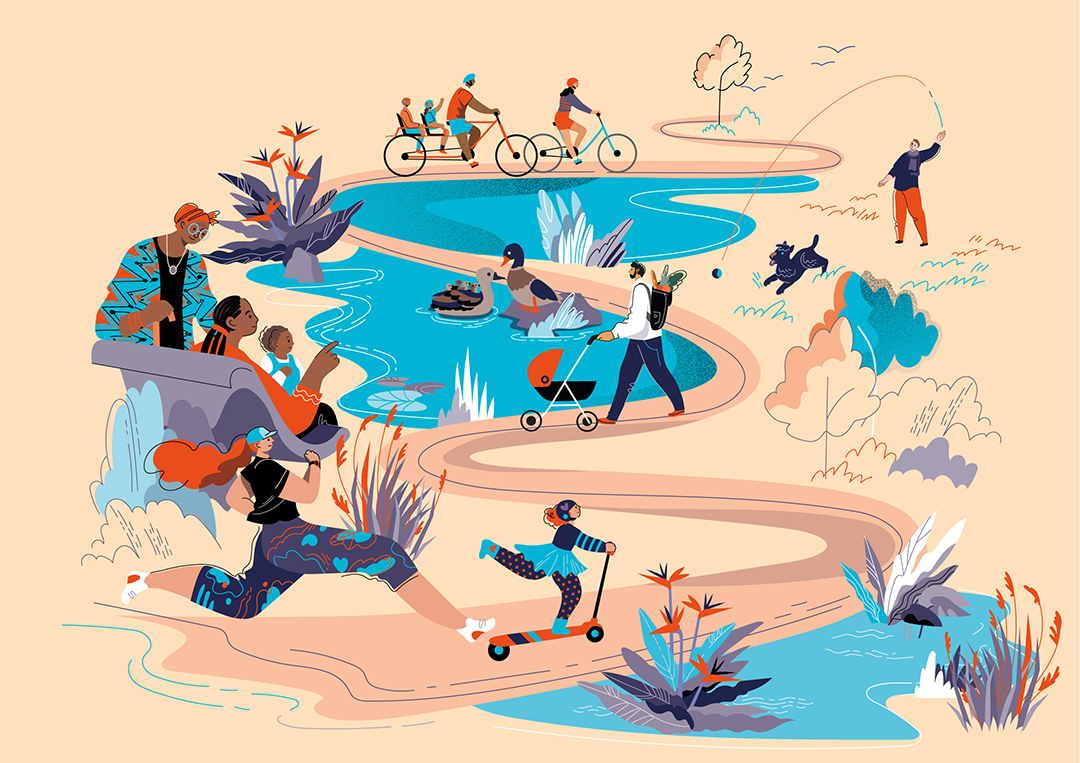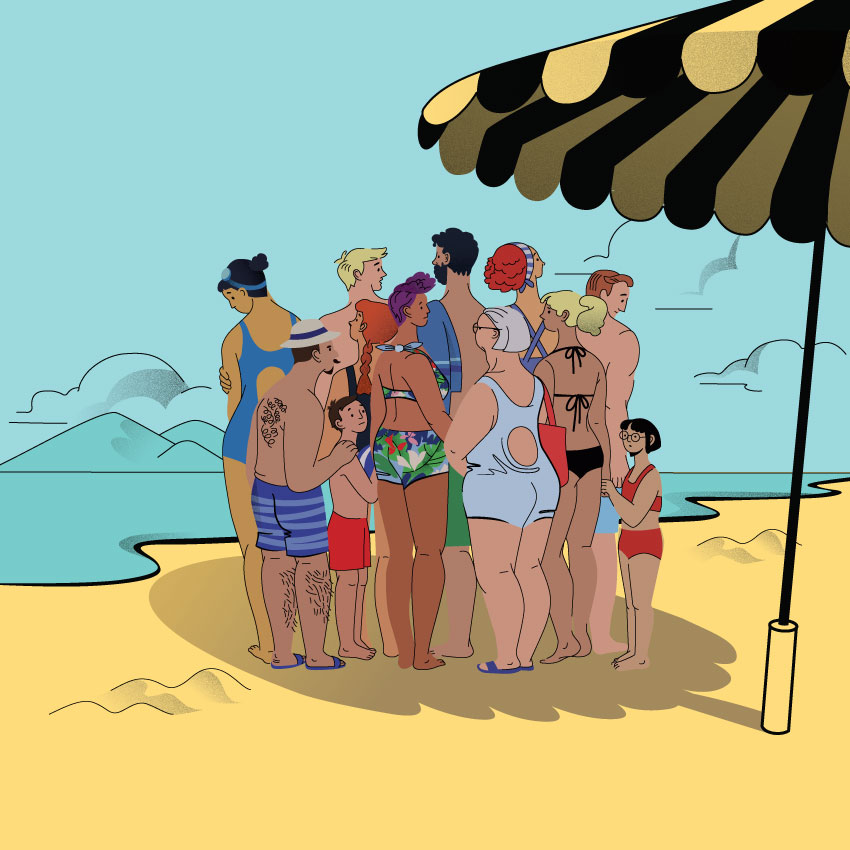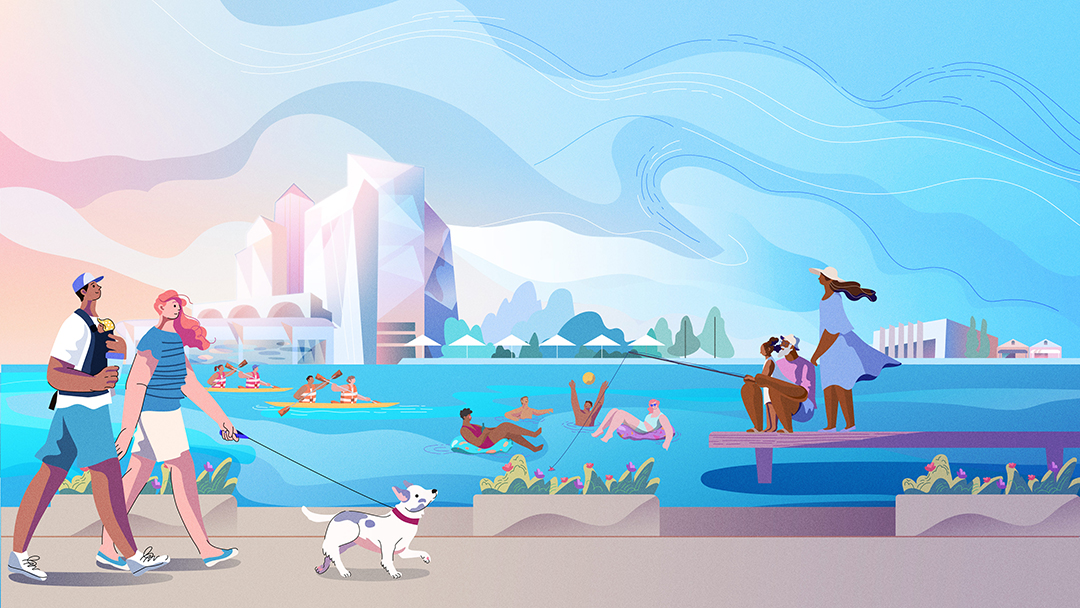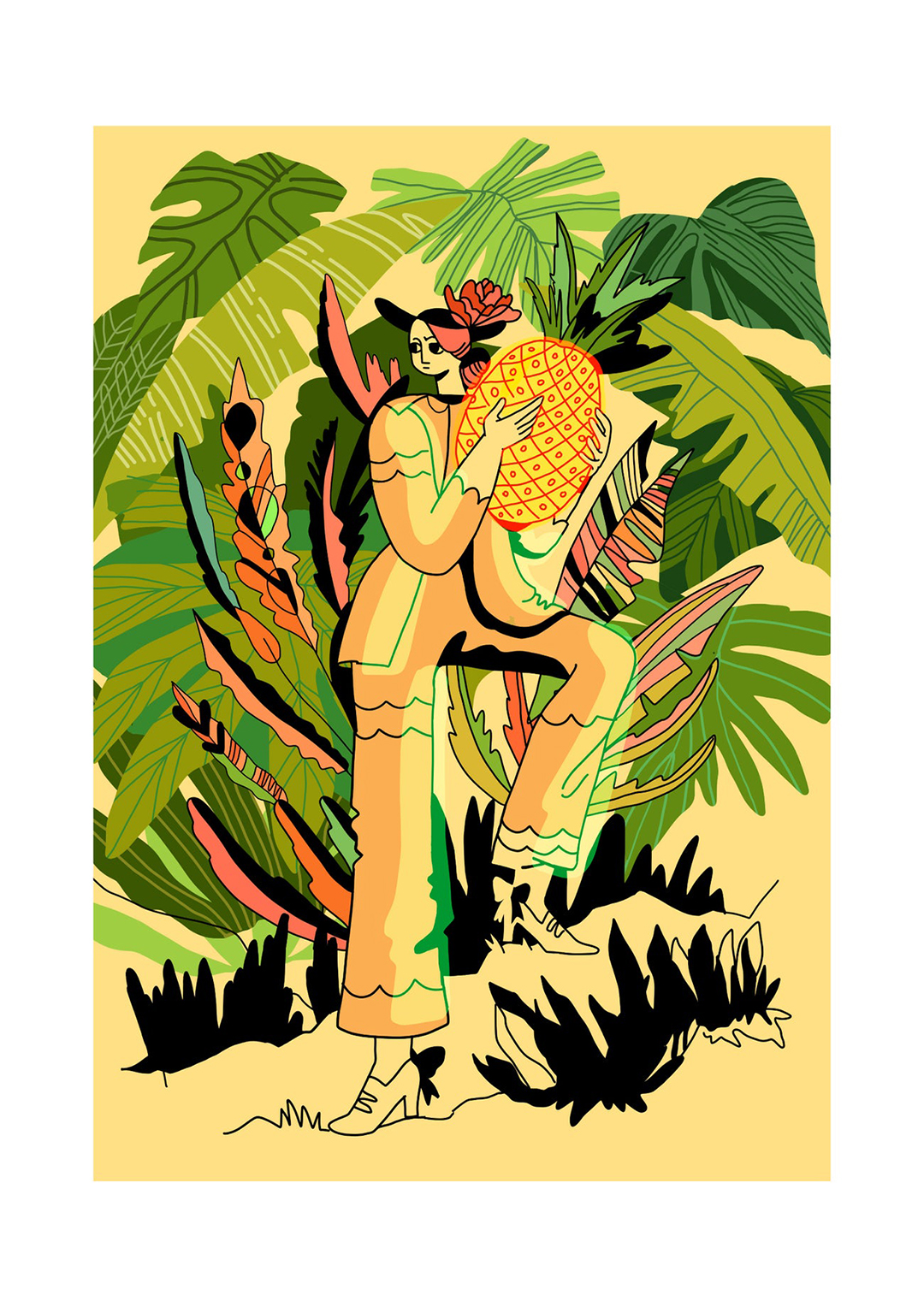Lilian Darmono
Meet visual artist and illustrator from Melbourne, Lilian Darmono

Tell us a little bit about yourself.
I am a cis-hetero, female Asian-Australian illustrator and artist based in Melbourne, in my early 40s. I’m a working parent. Most of my work is about creating illustration assets for explainer videos and apps. I freelance for various motion design studios around the world, as well as doing more ‘traditional’ illustration work via my rep Jacky Winter.
These days it’s a mad juggle between parenting my 4 year old and client work. In whatever little ‘me-time’ I have, I garden, swim, and paint in watercolour or acrylic for pleasure.
Describe the city you’re living in and what it’s like to live there.
Melbourne is a very food-obsessed, left-wing, diverse city with European vibes. Our coffee is one of the best in the world. The weather is super fickle, the art scene is thriving. It’s beautiful. Racism and inequality still happen, but as an Asian migrant woman, I feel relatively safe and accepted here.
Melbourne is a very food-obsessed, left-wing, diverse city with European vibes. Our coffee is one of the best in the world. The weather is super fickle, the art scene is thriving. It’s beautiful. Racism and inequality still happen, but as an Asian migrant woman, I feel relatively safe and accepted here.
What is the best and worst thing about living in your city?
Best thing is the eating out scene, and our state government. Really progressive and compassionate, pursuing agendas that I care about like sustainability, equality, and care for the least fortunate. Compared to London where I’ve lived for 7 years in total, I’m not misunderstood here, as an East Asian. For a city where the majority of the population is of Anglo/Caucasian ethnicity, our cuisine is considered a staple. Even little white kids know how to use chopsticks at a young age, and Thai Jasmine rice is available at reasonable prices in most supermarkets.
Worst thing: we’re so far away from everything. Fly for 4 hours from London and you’re in Eastern Europe or North Africa. Fly for 4 hours from Melbourne and you’re still in Australia….
Give us 3 words that describe what it’s like to be a creative in your city.
Thriving
Supported
Vibrant
How did you start your career in art?
I’ve been drawing all my life. As soon as I could hold a pencil at age 3 or 4. Drawing, and reading books with beautiful illustrations in them. A ton of exposure to English watercolour illustrations of fairy tales and folk tales. I come from a family of lower-middle class Chinese migrants in Indonesia, and money was always tight, but my parents always found a way to buy me a new storybook every few months. I had a wealthier cousin who took up Graphic Design, and thought that’s the only way to make a living by being a creative professional.
I left home at 14, I won a scholarship to go to Singapore for my highschool education. For the last two years of it, I had to choose between being an artist or a doctor. I asked my dad and he said my heart is too gentle to become a doctor, so I ended up choosing Art. I took it quite seriously, did very well in my Higher Art subject (equivalent to any foundation course in any Art colleges in UK and US), and eventually winning another scholarship for a Graphic Design undergrad programme in Melbourne, Australia.
However, after having completed an internship and graduating, I discovered Print Graphic Design is not the right fit for me. In my final year, I got a taste of After Effects, and decided to pursue Motion Design, getting a postgrad in Multimedia Design in 2003, just when the field was taking off.
After working full time for several years in Sydney and Melbourne, I decided to go freelance and travel the world. My partner and I left for London in late 2008.
My big break came around that time, when I criticised Motionographer, (thanks to two senior female colleagues who encouraged me to do so), for not having a single female contributor. To his credit, the founder, Justin Cone, took me and two other women on board. My professional world broadened considerably. A fellow contributor was a designer at Psyop at the time, his name is Jon Saunders. He kindly shared his photoshop working file with me and that taught me how to do a certain style of digital illustration that was really popular at the time. I did a personal project during my first few months in London, during the height of the Global Financial Crisis, just to stop myself from getting depressed.
Here it is:

I put that up to my folio site, sent it to my motionographer colleagues, and they liked it enough to post it (yes it is somewhat nepotistic in retrospect, hey?), and offers to create styleframes for pitches started pouring in from US studios. Being based in London was really handy, we’re only 6 hours ahead of NYC, where most of the work came from. Gradually I stopped animating, as this type of work was better paid and more fun (for me). I got to know some wonderful animators too, whose dedication and skills made me realise that I didn’t love animation/moving image as much as I loved illustration. So in a roundabout way, decades later, I went back to becoming an illustrator.
The advantage for me was, even though I did not animate anymore, I still knew the workflow well enough to be able to draw things in the right way and supply them just so, to make life easy for animation teams. I ended up earning quite a decent living, and I could afford to travel to Europe every 3 months or so from the UK.
But the desire was always to return to Melbourne. No other place in the world feels more like home to me, so after two separate moves back and forth between London and Melbourne, we decided to go home for good, in 2017, with our 11 month old son, two cats, and lots and lots of boxes. I’m settled and happy now, can’t imagine being anywhere else!
Were the people around you supportive of your decision on working as a creative?
Yes. I asked my dad when I was about 16 years old, if I should choose science stream or arts stream? A doctor or an artist? My dad said my heart is too gentle to be a doctor. I’m glad I followed that advice.
I want to work more with physical surfaces. Get a mural commission, a range of homewares, or something that doesn’t only exist in the digital realm.
What are some goals and ambitions you have for your future work?
I want to work more with physical surfaces. Get a mural commission, a range of homewares, or something that doesn’t only exist in the digital realm.
If you could collaborate with any person in the world who would it be?
As an artist, I would love to have a group exhibition exploring identity and the growing pains of defining who we are, with any other Asian women who are currently living in a western society.
As an illustrator, I’ve been lucky enough to find really amazing animation studios that turn my work into animated pieces, so more of that, forever, would be great!
To evolve my style bit by bit so I don’t get stale. To find enough time for traditional media, life drawing, personal art, anything for myself, not for clients.
What are the biggest challenges you face in working as a creative?
To evolve my style bit by bit so I don’t get stale. To find enough time for traditional media, life drawing, personal art, anything for myself, not for clients.
How would you describe the women around you?
Definitely all are feminists, educated, upper-middle class women. However, because I have no close blood relative here, and my husband is an Anglo Australian, the women I see the most are his sisters and mum. They’re all generous, loving, kind, and I’ve known them for 18 years, but not having come from the same ethnic background, there would always be gaps in that shared experience/understanding that I often long for. Not a single one of them would have experienced racism, for instance. Not in the in-your-face, confronting way, or have been sexually objectified and stereotyped because of the colour of their skin by men who aren’t of their ethnicity. So I have all this build up of wounds from microaggression and casual (and not-so-casual) racism that they definitely sympathise with, but can’t relate to.
Were there any local female creatives that you looked up to when you were growing up?
No, because, obviously, the field is so male-dominated, and equality is really lacking. I can’t think of a single accomplished painter in Indonesia who’s a woman. However, one of my most treasured childrens’ books from my childhood was illustrated by Hilda Boswell, an English watercolourist. But I was too young to understand the concept of looking up to a role model, I just knew I loved her work.
I never thought there’s anything wrong with this, because I too, believe that meritocracy is real–that people get to the top position because they’re super talented, super hard-working, and unconscious bias has nothing to do with it. If I knew there’s something wrong with this belief, I would’ve sought to correct it, but I didn’t know, so I didn’t try.
Don’t measure yourself against THEIR standard. They = male dominated industry, or simply other artists, etc etc. Know your worth. Keep fighting for equality, but also know that you are enough and the only competition you should worry about is yourself. Keep striving to be a better version of you, day by day.
Do you have any advice for other women who are aspiring to work in your field?
Don’t measure yourself against THEIR standard. They = male dominated industry, or simply other artists, etc etc. Know your worth. Keep fighting for equality, but also know that you are enough and the only competition you should worry about is yourself. Keep striving to be a better version of you, day by day.
What type of music do you like to listen to?
All kinds except new music. I can’t stand anything created after 2010. I believe this is biological. Our parents can’t stand our music, and so now it’s only natural that I can’t stand the music that young people listen to.
What’s your favorite local food spot?
Any of the 4 local cafes we eat brunch at, and one gelato bar that serves Indonesian/South East Asian flavours, 10 mins walk from my house.
Knight Zhang asks: What is something you struggle with as a creative that you don’t think is talked about enough in communities or online spaces?
That meritocracy is a myth. That your starting point in life (where and how you’re born–your skin colour, how rich your family is, how educated, whether you’re born in a developing nation or an industrialised one) actually affects where/how far you’d go in your career.
The industry doesn’t like acknowledging this, I guess because the industry is still not diverse enough, and the demographic who’s got the most power doesn’t like being made to feel that their success has A LOT to do with the privilege that comes with the circumstances of their birth.
There’s a constant buzz around ‘making it’ to some kind of shortlist of the most talented creatives in this sector or that. ‘30 under 30’. I had a real crisis when I was about to turn 30, I have gotten not very far, despite having worked my butt off, and did all the ‘right things’. I was very insecure, frustrated, depressed.
Only now that I’m older that I can look back and think how unfair this yardstick is. Imagine if you’re from a poor family who has to take up night classes on top of juggling several part-time jobs to pay the bills, and don’t get to have your own computer until you’re 25? How do you compete with others who gets GIVEN a personal computer at 16 and starts mucking around with software/coding/filmmaking/whatever right then and there?
But again, the industry doesn’t like talking about this, because some of the power holders rely on this division/separation that has been created, (which on occasion seems very, very arbitrary)—between those who are perceived as the ‘top players/inner circle’ vs everyone else. Award shows, for example, as well as conferences, podcasts, online schools, and various other entities who make money out of the community rather than paying clients, rely on the desire of those who are on the outside, to ‘make it’ into the ‘inner circle’. So on and so forth.
Siqi Song asks: What is the best reaction you get when others see your work?
I have several, but top of the list is when people tell me my work makes them feel ‘seen’ and represented. That what I get paid to do somehow helps people feel less invisible, less isolated or lonely. That’s very very rewarding.
What question would you like us to ask the next artist?
If you can name one moment that’s a ‘turning point’ in your artistic career, what would that be?
Photos courtesy of Lilian Darmono
Website:
Instagram:
Facebook:
Twitter:
Category:
AustraliaDate:
April 16, 2021














